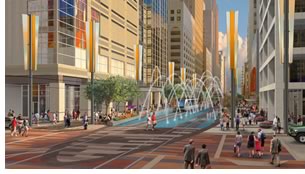

Convention Programs Help Hone Your Skills for Building Livable Communities
 Resolve
to learn more about creating livable communities while you attend the
AIA convention, which takes place May 8-10 in San Diego this year. Among
the learning activities you can choose are “Embracing the Future:
Community Visioning Training for Architects” (a half-day pre-convention
workshop on May 7) and two convention seminars: “Taking a Stand
for Better Design: Architects as Advocates” and “The Legal
Limits on Design: Land Use Law for Architects.”
Resolve
to learn more about creating livable communities while you attend the
AIA convention, which takes place May 8-10 in San Diego this year. Among
the learning activities you can choose are “Embracing the Future:
Community Visioning Training for Architects” (a half-day pre-convention
workshop on May 7) and two convention seminars: “Taking a Stand
for Better Design: Architects as Advocates” and “The Legal
Limits on Design: Land Use Law for Architects.”
Visioning training for architects
Arrive in sunny San Diego a day before the convention this year and take
advantage of one of the 18 half-day programs (3.75 LUs) or 8 full-day
programs (7.5 LUs). For instance, one designed to equip architects with
the skills to run public meetings and facilitate community discussions
about preferred futures, “Embracing the Future: Community Visioning
Training for Architects,” provides hands-on training on how to design,
manage, and facilitate community-visioning processes. Attendees will take
part in mock visioning processes. Workshop teachers are Tony Costello,
FAIA, Ball State University’s Irving Distinguished Professor of
Architecture and principal of Costello + Associates; Dr. Shirl D. Buss.
Assoc. AIA, San Francisco State University department of design and industry;
Michael E. Willis, FAIA, founding principal of Michael Willis Architects;
and Bruce Race, FAIA, founding principal of RACESTUDIO. Check out workshop
WE01, Wednesday, 8 a.m.–noon.
Showcasing architects as advocates
Few architects doubt that their communities would be substantially more
attractive and livable if they were more active as advocates for a better
built environment. The “Taking a Stand for Better Design: Architects
as Advocates” will demonstrate that they are right. Three architects
will use case studies to describe their involvement in advocacy for a
more livable built environment and the results for their communities.
The program, designed to inspire architects to become more involved in
the public-policy debate in their communities, will educate them about
the advocacy roles they can play and offers advice about how to get involved.
The program’s case studies will focus on efforts to:
• Reclaim the site of a San Francisco freeway that collapsed in
the 1989 Loma Prieta earthquake and reconnect downtown to the waterfront
• Revitalize Houston’s Main Street corridor and transform
it into the city’s own “Champs Elysees”
• Develop and promote a light-rail plan in Kansas City through
intelligent, citizen-responsive urban design.
Speakers for the session are Clark D. Manus, FAIA, Heller Manus Architects, San Francisco; Peter H. Brown, FAIA, Civic Design Associates, Houston; and E. Crichton (“Kite”) Singleton, FAIA, Kansas City. Check out Seminar TH10, Thursday, May 8, 2–3:30 p.m.
Learn land-use law
Although architects might prefer to design on a blank slate, the reality
is that their designs are limited not only by the demands of their clients
but by federal, state, and local development controls. The universe of
legally permissible designs is a limited one. In “The Legal Limits
on Design: Land Use Law for Architects” seminar, architect, attorney,
and urban planner Robert Sitkowski, Esq., AIA, AICP, will discuss the
legal limitations placed on an architect’s designs. The program
will introduce participants to the concepts and vocabulary of land-use
regulation, including the many new concepts and terms that have evolved
out of the Smart Growth and New Urbanism movements and the increase in
“NIMBYism.” He also will provide participants with practical,
experience-based advice on how to negotiate the processes for obtaining
federal, state, and local land-use and design approvals. Check out Seminar
FR27, Friday, 2–3:30 p.m.
Copyright 2003 The American Institute of Architects.
All rights reserved. Home Page ![]()
![]()
 |
||
| For more information about the livable-community programs, contact AIA Livable Communities Director John Ratliff, 202-626-7405 or jratliff@aia.org. For more information about convention programs or to register,
visit the convention Web site.
|
||